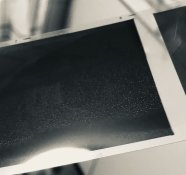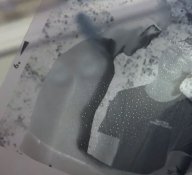You are using an out of date browser. It may not display this or other websites correctly.
You should upgrade or use an alternative browser.
You should upgrade or use an alternative browser.
Stain on film, please help
-
A
- Thread starter malcao
- Start date
Recent Classifieds
-
For Sale Durst Laborator L 184 LACON Condensor set
- Started by jbrianfoto
-
For Sale Durst Laborator L 184 Lamphouse and Bulb Adjustment Mechanism
- Started by jbrianfoto
-
For Sale Durst Laborator L184 accessories; VADAP tilting Baseplate
- Started by jbrianfoto
-
Free Mini Radio triggers: Light pix lab Flash Q
- Started by RoboRepublic
-
Want to Buy Kodak Polytoner
- Started by Guillaume Zuili
Forum statistics
pentaxuser
Member
What is the picture we are looking at? All I can see is black with many white specks on it and what look s like the edge of a small white disc on the bottom. I assume this is the negative? is this the only negative affected/ What do the rest of the negatives looks like? Are they all OK?
pentaxuser
pentaxuser
Yes, it's the negative and all film is affected. On dark areas on the negative it's very visible at an angle against the light, or else it's difficult to see and even more difficult to take a photo. The white disc at the bottom is a reflection of the celling light. I have been thinking things over and the only thing I done different is taking the film out of refrigerator and had it in my pockets maybe 30min before developing. Could it be humidity that could cause this?What is the picture we are looking at? All I can see is black with many white specks on it and what look s like the edge of a small white disc on the bottom. I assume this is the negative? is this the only negative affected/ What do the rest of the negatives looks like? Are they all OK?
pentaxuser
Yes, absolutely. It looks like damage to the emulsion and tiny condensation droplets may very well play a role.Could it be humidity that could cause this?
Yes, absolutely. It looks like damage to the emulsion and tiny condensation droplets may very well play a role.
Ok. Thanks. The emulsion isn't damaged, since when I rinse a second time everything is ok.
pentaxuser
Member
So what we are talking about are the multiple white dots on the negative?. The negative does not seemed to have puzzled anyone else except me but frankly I cannot even see anything on it that resembles a picture of any kind. This may be a separate problem if your concern is only with the white specks but something to my eyes appears to have gone clearly wrong in the development. So let me ask again what is this a negative of?
Thanks
pentaxuser
Thanks
pentaxuser
That's fortunate, so all you need to do is just wash the film?Ok. Thanks. The emulsion isn't damaged, since when I rinse a second time everything is ok.
So what we are talking about are the multiple white dots on the negative?. The negative does not seemed to have puzzled anyone else except me but frankly I cannot even see anything on it that resembles a picture of any kind. This may be a separate problem if your concern is only with the white specks but something to my eyes appears to have gone clearly wrong in the development. So let me ask again what is this a negative of?
Thanks
pentaxuser
It's on different parts of the film, it's only that you see it much more clear against dark part of the negative. Here is another photo of a negative
Attachments
That's fortunate, so all you need to do is just wash the film?
Yes
 one or two times.
one or two times.pentaxuser
Member
Thanks. Based on the first negative I saw the white dots but the rest of the negative was mainly black as if something had gone wrong with the processing. I can now see this was not the caseIt's on different parts of the film, it's only that you see it much more clear against dark part of the negative. Here is another photo of a negative
Glad the spots could be washed off
pentaxuser
Ok. Thanks. The emulsion isn't damaged, since when I rinse a second time everything is ok.
So this was dirt left by the water.
After wasing you may make a final rinse with distilled water, you may keep and reuse that distiled water to be used several times.
tezzasmall
Member
As it's cheapish, I prefer to use the distilled water just the once for rinsing - just in case.So this was dirt left by the water.
After wasing you may make a final rinse with distilled water, you may keep and reuse that distiled water to be used several times.
Terry S
So this was dirt left by the water.
After wasing you may make a final rinse with distilled water, you may keep and reuse that distiled water to be used several times.
Don't know and not sure it's dirt left by water.
Never occurred before and if it's dirt shouldn't all part of the film have dirt?
And why is there never dirt when I rinse a second time?
It dosen't look like dirt.
Water quality in Sweden is good.
For now, waiting for reply from Ilford.
No reply from Ilford.
I have some own theories. I often develop in the evening and it's a little colder and higher humidy that makes the film dry more slowly. Also I could have to much wetting agent? The part of the film that dries last will have the marks. When I rinse the film again in the morning, it's öess damp and warmer and the film dries faster.
Just a theory.
I have some own theories. I often develop in the evening and it's a little colder and higher humidy that makes the film dry more slowly. Also I could have to much wetting agent? The part of the film that dries last will have the marks. When I rinse the film again in the morning, it's öess damp and warmer and the film dries faster.
Just a theory.
Then squeege your film before hanging to dry.The part of the film that dries last will have the marks.
pentaxuser
Member
Yes, try shaking the film from the top to make it move like a snake and then squeeze the film between your two middle fingers so they act like a squeegee tool but with the added advantage that there will be no grit between your fingers which is a risk with rubber-bladed squeegees. I find this works well. The only time it didn't was when I had to fix Kodak TMax film for 10 mins and decided to mix some cement-mortar and lay a couple of bricks while waiting for the fix. The grit from cement-mortar can get between your fingers unless you spend a lot of time washing your hands. These day I still use the time to lay bricks( TMax films take a long time to fix - expensive as wellThen squeege your film before hanging to dry.
 ) but I have the wife do all the cement-mortar mixing and laying. I simple do the clever bit which is placing the brick on the cement-mortar
) but I have the wife do all the cement-mortar mixing and laying. I simple do the clever bit which is placing the brick on the cement-mortarIf it wasn't for the wife I'd probably not be able to cope

pentaxuser
With 120 roll film or sheet film I've never seen the need to squeegee. Only with 35mm. But I don't find the risk acceptable - whether a squeegee is used, hands or whatever other material/utensil, there is *always* the risk of scratching and it's enormously frustrating to have some otherwise usable negatives that have a scratch running across them that'll show up in every print or scan. I'd strongly recommend working out a wash regime and finishing process that precludes any physical contact with the film as long as it's wet.
The OP has an unsolved problem and only finds it at the parts drying the latest. To me squeeging the film to not yield that surplus of fluid seems the logic approach. Being deterred by another imaginable problem that the majority of fellows who apply squeeging did not experience when an actual problem exists that likely can be countered, seems counterproductive to me.
foc
Subscriber
The squeegee is your friend, but you need to know how to use it.
- Soak it in warm water with a tiny drop of wetting agent.
- Gently run your fingers along the squeegee blades to check for grit or nicks in the rubber.
- Let the blades gently "kiss" the film ( think, gentle lover rather than sadistic gouging ).
- Squeegee in one smooth and gentle movement.
pentaxuser
Member
- Let the blades gently "kiss" the film ( think, gentle lover rather than sadistic gouging )
So possibly for visualisation purposes, more like Audrey Hepburn rather than Sharon Stone?

pentaxuser
| Photrio.com contains affiliate links to products. We may receive a commission for purchases made through these links. To read our full affiliate disclosure statement please click Here. |
PHOTRIO PARTNERS EQUALLY FUNDING OUR COMMUNITY:  |











